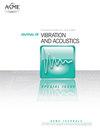A Multiple-Burner Approach to Passive Control of Multiple Longitudinal Acoustic Instabilities in Combustors
IF 1.9
4区 工程技术
Q2 ACOUSTICS
Journal of Vibration and Acoustics-Transactions of the Asme
Pub Date : 2023-10-13
DOI:10.1115/1.4063550
引用次数: 0
Abstract
Abstract Presently, passive methods of controlling combustion instability fall short when one considers stabilizing multiple acoustic modes. In this paper, we present a passive control approach based on the locations of the burners to stabilize multiple acoustic modes. The approach is demonstrated using linear stability analysis performed on a canonical open–open rectangular tube enclosing a flame. A linear flame model based on the kinematic description of the flame surface is used. A simultaneous solution method, as opposed to a segregated method, is developed to calculate the mean flow and to evaluate mode shapes and eigenvalues. The stability analysis is performed both on single and on multiple-burner combustors. In the latter case, the axial and transversal arrangement of burners considered preserves the net volumetric heat release rate and exit temperature. The problem of stabilizing the first three acoustic modes is cast as a multi-objective optimization problem for both types of combustors using the location(s) of the burner(s) as decision variable(s). We show that the use of multiple burners markedly increases the stability of the first three modes while not disturbing the combustor design parameters.燃烧室多重纵向声不稳定性被动控制的多燃烧器方法
目前,控制燃烧不稳定性的被动方法在考虑稳定多种声模态时存在不足。在本文中,我们提出了一种基于燃烧器位置的被动控制方法来稳定多种声模式。该方法是用线性稳定性分析进行了典型的开-开矩形管封闭火焰。采用基于火焰表面运动学描述的线性火焰模型。同时求解的方法,而不是分离的方法,开发计算平均流量和评估模态振型和特征值。对单燃烧器和多燃烧器燃烧器进行了稳定性分析。在后一种情况下,考虑的轴向和横向燃烧器布置保留了净体积热释放率和出口温度。稳定前三种声学模态的问题被视为两种类型燃烧器的多目标优化问题,使用燃烧器的位置作为决策变量。我们表明,使用多个燃烧器显着增加了前三种模式的稳定性,同时不干扰燃烧室的设计参数。
本文章由计算机程序翻译,如有差异,请以英文原文为准。
求助全文
约1分钟内获得全文
求助全文
来源期刊
CiteScore
4.20
自引率
11.80%
发文量
79
审稿时长
7 months
期刊介绍:
The Journal of Vibration and Acoustics is sponsored jointly by the Design Engineering and the Noise Control and Acoustics Divisions of ASME. The Journal is the premier international venue for publication of original research concerning mechanical vibration and sound. Our mission is to serve researchers and practitioners who seek cutting-edge theories and computational and experimental methods that advance these fields. Our published studies reveal how mechanical vibration and sound impact the design and performance of engineered devices and structures and how to control their negative influences.
Vibration of continuous and discrete dynamical systems; Linear and nonlinear vibrations; Random vibrations; Wave propagation; Modal analysis; Mechanical signature analysis; Structural dynamics and control; Vibration energy harvesting; Vibration suppression; Vibration isolation; Passive and active damping; Machinery dynamics; Rotor dynamics; Acoustic emission; Noise control; Machinery noise; Structural acoustics; Fluid-structure interaction; Aeroelasticity; Flow-induced vibration and noise.

 求助内容:
求助内容: 应助结果提醒方式:
应助结果提醒方式:


